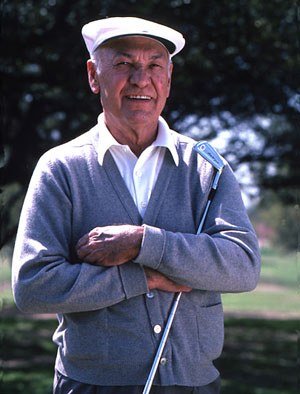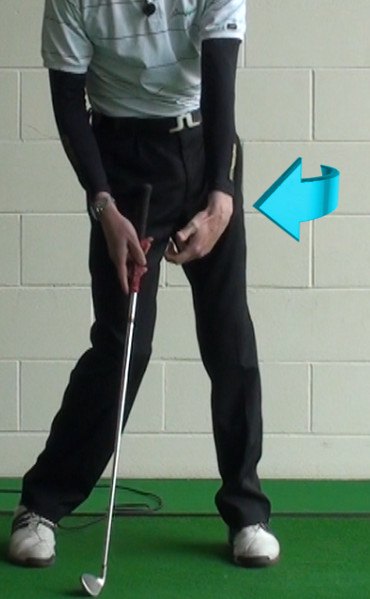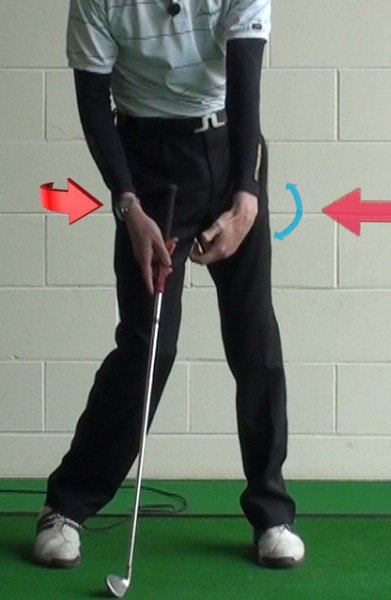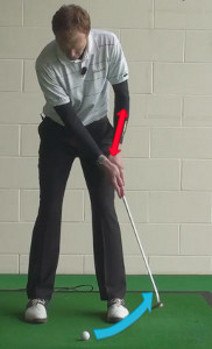
Ask any tour pro or golf swing student, “Whose impact position would you most like to copy?” The vast majority will answer, Ben Hogan's.
Sixty years after his heyday, Hogan remains the gold standard for pure ballstriking. And his impeccable impact pose is the envy of every serious golfer. More specifically, Hogan's bowed left wrist is the subject of much awe.
It's something all golfers should aspire to copy. We'll provide a helpful drill momentarily; first, let's study the bowed wrist in more detail.
At the instant when club met ball, the back of Hogan's left wrist pointed directly down the target line, with a slight but notable outward bowing. This created a small angle between the left forearm and shaft, assuring that the hands remained in front of the clubhead, the shaft leaning toward the target, when the ball was struck. Voila! Compression of ball against turf -- the key to long, penetrating iron shots.
Of course, Hogan was one of golf's most accurate players because his left wrist position squared the clubface consistently. Even if you never achieve his bowing action, developing a flat wrist position will improve your ability to hit the target.
Rather than consciously trying to flatten out your wrist at the moment of contact, it's important to recognize this position as a by-product of proper swing technique. In other words, get the fundamentals correct and the magic moment will happen naturally.
As promised, here's a practice drill to get you trapping the ball, Hogan-style:
- Start with a short iron and set up with the ball in the center of your stance.
- The shaft should lean toward the target, with your hands ahead of the ball.
- The left arm and shaft should form a straight (or nearly straight) line from shoulder to ground.
- Before taking the club back, lift your right heel, but keep your toes touching the ground. This will tilt your body ever so slightly, promoting a downward strike.
- Swing normally, and continue hitting shots until your contact is consistently solid. You should make a divot with each swing.
- Switch to a longer club, hit several more shots, and so on through the bag.
If you're making crisp contact and hitting straight, penetrating shots, you're getting the hang of this flat-wrist thing – without even thinking about it.

Bowed Left Wrist to Square Clubface – Ben Hogan
You don't need to be a golf historian to know that Ben Hogan is one of the legends of the game. Considered to be perhaps the best ball striker in golf history, Hogan's swing is the gold standard to which all other swings are compared. Countless golfers over the years have tried to emulate pieces of the Hogan swing in order to improve their own games. While you will almost certainly fall short of the standard set by Hogan himself, you can learn plenty from the methods he used to strike the ball. In this article, we are going to look at one specific element of Hogan's swing – the bowed left wrist.
At impact, Hogan had his left wrist in a bowed position, which is now standard operating procedure for any quality player. Where most amateur golfers find their left wrist in a cupped (or 'concave') position at impact, the professional golfer knows that the left wrist needs to be bowed out toward the target. Doing so will help to hold the clubface square through the hitting area, giving the player a better chance to hit a quality shot. If you currently strike your shots with a cupped left wrist, making the transition into a bowed wrist position should be one of your top priorities.
The bowed left wrist is important in large part because it is a signal of other things you have done properly earlier in the swing. If your left wrist is bowed when you contact the ball, it is almost certain that you have held your angle nicely in the downswing. Most golfers struggle mightily to hold onto the angle between their left arm and the shaft while swinging down – a technique known as lagging the club. One of the biggest differences between amateurs and professionals in the fact that pros lag the clubhead beautifully in the downswing, while amateurs throw away their angle right from the top. Think about the bowed left wrist as being an evaluation of your ability to hold lag. Strike the ball with a bowed wrist, and you can feel great about the lag which led up to that point.
Everything about your ball striking will improve when you manage to incorporate the bowed left wrist in your technique. Not only will you strike the ball with most power, but you should make cleaner contact as well. With a crisp strike occurring at the bottom time after time, you will have a newfound confidence in your ability to hit targets. Is it going to be easy to learn this move? No, probably not. It will be worth it, however, if you can manage to develop your game to the point where you are cleanly impacting the ball on each swing with the help of a bowed left wrist. Imitating this one technique is not going to turn you into Ben Hogan on the links, but it will help you become the best golfing version of yourself.
All of the content below has been written from the perspective of a right-handed golfer. If you happen to play left-handed, please take a moment to reverse the directions as necessary.

The Benefits
Before you undertake the process of learning how to place your wrist into a bowed position at impact, you need to know how your game can benefit in the long run from such a change. We have already touched on some of these benefits in the introduction, but they should be expanded on before we continue. Having these benefits in the back of your mind will serve as motivation – if you ever have doubts about putting in the work to reach this goal, look back to these benefits and stay on the right path. In the end, your game will reward you with dramatically improved performance.
- Eliminating the hook. There is nothing nice you can say about a hook. As anyone who has ever fought a hook will tell you, it is impossible to play good golf with such a ball flight. If you are hooking the ball quickly to the left, the rest of your game will basically be irrelevant – because you won't be able to stay in play. Hooked shots almost always find trouble before they stop moving. There is an old saying in golf that goes something like the following – 'you can talk to a fade, but a hook won't listen'. This statement is accurate, and it highlights why you need to avoid the hook at all costs. A ball fading from left to right might not hit your target, but it will usually stay somewhere on the course. On the other hand, a hook will miss your target dramatically, and you may find yourself reaching for another ball.
- Solid contact. The advantage of hitting the ball solidly should be obvious. A solid strike is going to help you hit the ball the proper distance time after time, which is a big part of the challenge when on the course. If you can hit most of your shots the right distance, you will be well ahead of the game. Also, making solid contact gives you confidence that you can avoid the hazards you are sure to come across during your rounds. Have to carry the water on a par three? Not to worry – thanks to the clean contact you are making with your bowed left wrist, you should be able to make it safely to the other side.
- Create impressive backspin. As you will be hitting down through the ball nicely when you keep your left wrist flat, you should produce quite a bit of backspin – especially on your short iron shots. If you have ever wondered how professional golfers get their wedge shots to 'back up' after they land on the green, it is because they hit down through the ball nicely (and they use the right equipment). Since it is nearly impossible to hit down while your left wrist is cupped, paying attention to this fundamental is going to help you generate spin and control your ball after it lands.
It should be noted that your left wrist doesn't actually have to be bowed toward the target at impact. What is important is that you avoid cupping your left wrist as you swing down toward the ball. As long as your left wrist is at least flat, if not slightly bowed, you should be in in good shape.
For the player who is used to contacting the ball with a cupped left wrist, the feeling of making contact while the left wrist is flat will be incredible. Shots struck this way feel far more solid than any shot hit with a cupped wrist, so it often only takes one or two successful swings for the player to become 'addicted'. Once you know what it is like to hit the ball cleanly with a flat left wrist, your only concern will be to master this move so you can do it over and over again.

The Right Hand Dilemma
As a right-handed golfer, your right hand is naturally your dominant one. When swinging the club, it only seems natural that you should use your right hand aggressively, since it is the one which is used actively in day to day life. However, that isn't necessarily the case. As you swing down, you may be better served to leave the right hand out of the equation, letting the pulling action of your left hand lead the way.
The problem with letting your right hand do too much work in the downswing is a matter of timing. Many amateur golfers let their right hands become involved too early in the downswing, which leads to wasted lag and a poor impact position. If you are finding that your left wrist is cupped at impact, it is very likely that you are employing the use of your right hand prematurely on the way down. By letting your right hand simply go along for the ride, you will eliminate this risk and you will have a better chance of keeping your left wrist flat at the moment of impact.
While your right hand can certainly get you in trouble during the golf swing, there are still many golf teachers who promote its active use. Why is that? Well, when timed perfectly, the right hand does have the potential to be a tremendous source of power. If you can 'trust yourself' to use it at just the right moment, you may be able to add yards to your shots by actively using the right wrist to release the club head through the ball. This is not easy, however. For most amateur players, it will be better to stick with the idea of leading with the back of the left hand while the right just goes along for the ride. There will inevitably be a release of the right hand due to the momentum of the swing, which will be enough to send the ball on its way.
Of course, your left hand/arm can't do the job alone. You need to be building speed with the rest of your body along the way, which is where your lower body comes into the picture. From the top of the backswing on through to impact, you need to make sure that your lower body is rotating aggressively toward the target. This rotation will build speed and power which your upper body can use to propel the club into the ball. The average golfer struggles to incorporate his or her lower body properly into the swing, which is why so many amateurs lack power. Instead of relying only on your arms and hands to accelerate the club, turn that job over to your lower body. There are a lot of muscles in your legs and hips – put them to use and your game will improve.
One other point which needs to be mentioned in this section is the way you place your hands on the grip before the swing. You need to make sure that your two hands are working together properly on the grip, rather than fighting each other for space. Place your left hand on the grip first, then add your right hand to match. The hands should fit comfortably together, and your palms should be facing each other. As you swing, make sure there is no movement in your grip, as this is a sign of trouble. You should find yourself 're-gripping' the club at some point during the swing, go back to address and work on finding a better position for your hands. Using a stable, comfortable grip is going to make it much easier to arrive at an impact position which features a flat or bowed left wrist.

Starting Small
As you might imagine, altering your swing to the point where you can begin to hit the ball with a bowed left wrist is going to be a serious challenge. Even if you have a clear understanding of what you are trying to do, actually doing it is going to be something else altogether. For that reason, it is a good idea to start small. If you can start this process by hitting some simple chip and pitch shots, you will find the results you achieve with your full swing will come along much quicker. And, as an added benefit, you will get to improve the quality of your short game in the process.
A good pitch shot is nothing other than a miniature version of your full swing. You want to hit down on your pitch shots just as you do your full swings, and you should be lagging the club slightly in the downswing. To learn how to keep your left wrist bowed, or at least flat, at impact when pitching the ball, follow along with the drill below.
- Find a place to practice your pitch shots at your local golf course. Ideally, you will be able to use a practice chipping green for this purpose, but you can even pitch at the driving range if no green is available. As long as you find a spot which offers a good lie and at least one target to use, you will be good to go.
- Take your sand wedge from your bag to use for this drill. The sand wedge is a club which will often be called into duty for pitch shots, so it makes sense to get started with this option. Once you have worked through this drill once, you can try to perform it with other wedges if you would like.
- Pick out a target and set a ball down in front of you for the first shot. It is always important to pick a target even if you are working more on your technique than your ability to hit the ball close.
- Take your stance, place your hands on the club, and take one last look at the target. To this point, this drill should feel just like any other pitch shot you would hit on the course.
- With all of the preparations out of the way, there is nothing left to do except hit the shot. Make your swing, hit down on the ball at impact – and stop the club immediately upon striking the ball. This last point is where the drill is going to vary from a standard pitch shot. Instead of swinging through to a normal finish, you are going to abruptly stop the swing at the moment of impact. This is not a good idea when you are focused on creating quality pitch shots, but it will be helpful in this instance.
- Continue to hit as many pitch shots as you would like using this drill. When you are done, be sure to hit at least a few normal pitch shots to wrap up the session. You don't want to get into the habit of hitting your actual pitch shots without any follow through, so also finish with standard pitch shots to restore your technique.
So what is the point of this drill? By stopping at impact, you are going to be able to immediately observe the quality of your left wrist position. Is your wrist flat or bowed, or did you slip into a cupped position? If the wrist is cupped, you will know right away that something went wrong. In addition to looking at your list to check on your success, you can also watch the trajectory of the ball. If you pop the ball high up into the air immediately off the club face, it is almost certain that you cupped your wrist. Ideally, you will see a trajectory which starts relatively low, climbs slightly on the way to the target, and then stops quickly when it lands thanks to a high spin rate.
Once you have mastered the feeling of striking the ball with a flat left wrist by using this short game drill, go ahead and work your way up to some full swings. The idea is the same in the full swing, only the club will be moving faster and the rest of your body will play a larger role in the move. Instead of reaching straight for your driver after hitting some pitch shots, be patient and gradually hit the ball farther a little bit at a time. If you can spread this process out over the course of several practice sessions, you should be more successful in the long run.

Left Wrist on the Greens
Believe it or not, your left wrist is just as important on the greens as it is when making full swings. You need to have solid technique on your side if you hope to make as many putts as possible, and much of your technique is going to come back to the left wrist. However, rather than thinking about a bowed wrist, you really want to aim for a perfectly flat position when the putter contacts the ball. Do your best to set your wrist flat at address and then keep it that way while the putter swings back and through.
It will be easy to keep your left wrist flat while putting if you do a good job of using your shoulders to control the stroke. Those who rock their shoulders as the main mode of moving the club will have little trouble finding this important position at impact. On the other hand, if you allow your hands and wrists to dictate the movement of the club, it will always be difficult to hit your target lines. You need to be consistent with your stroke if you are going to make a lot of putts, and taking your hands out of the equation will go a long way toward promoting consistency.
One of the best ways to learn how to keep your left wrist flat while putting is to hit practice putts with only one hand. Set a few golf balls on the practice green and pick out a hole to use as a target. Take your stance over the first putt as usual, but take your right hand off the grip prior to starting the stroke. By using just your left hand, you will have no choice but to keep that wrist flat. If you were to cup the left wrist while putting one-handed, the results would be ugly to say the least. Hit a few one-handed putts before returning to your two handed technique to test out what you have learned.
It is always scary to copy even a small part of the golf swing of a legend such as Ben Hogan. While you aren't going to play at the same level as Hogan anytime soon, you can improve on your performance by learning from the importance he placed on the left wrist. Take the information provided above and get to work on sharpening your technique right away. Good luck!






